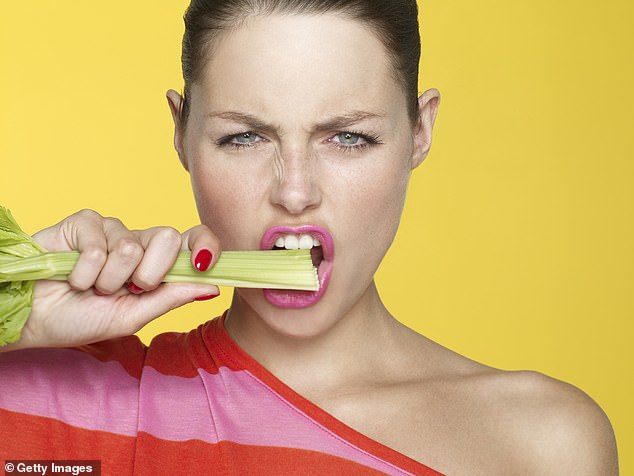Negative-calorie foods are big news on social media, with influencers extolling their virtues as a fast way to lose weight.
The claim is that when we eat certain foods – mainly fruit and veg, such as celery, cucumber, lettuce, melon and grapefruit – we burn more calories digesting them than they contain.
Scrolling through the huge number of posts on Instagram or TikTok, you’d be forgiven for thinking that the humble celery stick in particular is some kind of super-charged fat burner. Influencers such as Jake the Low Calorie Guy recommend snacking on celery or basing your diet mainly on similar foods to lose weight.
So is eating them a clever diet trick – or just another viral myth?
The ‘negative-calorie’ foods are essentially low calorie, high-water content plant foods.
The theory is simple: digesting food uses energy, and some foods are so low in calories and high in fibre that your body could burn more than you consume while still leaving you feeling full.
Celery, for example, has just six calories per large stalk, while half a medium cucumber contains roughly 25 calories.
With numbers that low, it’s tempting to imagine crunching your way to a slimmer you.

Celery has had a reputation as a ‘negative calorie’ food for a while – but is it justified?
Indeed diet books have been championing celery and cucumber as low-calorie snacks for decades.
So what about the science?
Professor Thomas Barber, an obesity expert and endocrinologist at University Hospitals Coventry and Warwickshire NHS Trust, has carried out experiments on this and tells the Daily Mail: ‘We found celery was effectively a calorie-deficit food.’
He recalls an experiment for Channel 4’s Food Unwrapped in 2016, which involved putting the show’s presenter, Matt Tebbutt, into a sealed metabolic chamber that precisely records the air going in and coming out.
As he explains: ‘By analysing the oxygen and carbon dioxide levels – something called indirect calorimetry – we could then calculate his metabolic rate both before and after eating, giving us exactly how many calories eating a particular food had burnt off.’
‘This is because when we eat a meal, our metabolic rate rises for two to three hours after, as our energy expenditure goes up.
‘This is mainly due to the liver working hard breaking down food and absorbing nutrients, and releases carbon dioxide in the process. This all requires energy. Called the thermic effect, it’s why you often feel hot or sweaty after eating a big meal.’
The celery experiment was revealing. ‘After getting the base-level reading of Matt’s metabolic rate, we gave him 53 calories’ worth of celery to eat and then measured his rate again over the next two hours,’ adds Professor Barber.


Professor Louise Dunford was dismissive of the findings of Professor Barber’s team
‘Surprisingly, we discovered he used 72 calories to metabolise the celery meal – a difference of 19 calories and a lot more than the generally accepted 10 per cent of total calorie content rule of how much energy is used to digest most meals.
‘So in this way, we found celery was effectively a calorie-deficit food.’
But Professor Barber is quick to point out that these findings don’t amount to a full-blown dietary strategy. ‘Indirect calorimetry using a metabolic chamber like this is an excellent way to assess metabolism and thermic effect of food in real time. But applying this to general dietary advice is missing the point.
‘Yes, negative calorie fruit and veg may exist, but that’s not the most interesting thing about them.’
He adds: ‘I personally feel there’s far too much focus on calories per se, rather than looking at good nutrition and the fact that these plant-based foods are actually very beneficial for our health.
‘Celery contains some key vitamins and minerals (including vitamins C and K, and potassium) and is high in fibre, which is a crucial part of a healthy diet.
‘Our over-reliance on low-fibre ultraprocessed foods means most of us eat only two thirds of what our bodies need to function well.
‘And plant-based foods such as celery are one of the best fibre sources – especially of the type of insoluble fibre our healthy gut bacteria need to feed on, something a wealth of evidence now shows is vital for overall good health,’ he explains.
Other experts are more dismissive about the existence of negative-calorie foods.
Dr Louise Dunford, a nutritionist and an associate professor at the University of Warwick, is unequivocal. ‘The idea is nonsense – and has no science to back it up,’ she says.

Pink grapefruit is another food said to help people lose weight due to its calorific content
She also disputes the calculations for negative-calorie foods.
‘Typical foods people pick out as being “negative calorie” are celery, grapefruit, cucumber – basically anything with high water and fibre content but very low calories (14-30 calories per 100g),’ Dr Dunford told the Daily Mail.
‘But the truth is, although these foods are low in calories, they also take far less energy to digest because of their high water content and the indigestible fibre they contain, which isn’t digested – it just passes through the digestive system,’ she explains.
‘It’s generally accepted that the energy required to digest meals is around 10 per cent of the total calories they contain, although this can vary depending on protein levels, as protein uses more like 20-30 per cent of the energy it contains to burn it off.
‘So celery is just a lower-calorie food not a calorie-deficit creator,’ says Dr Dunford.
‘These foods are not some magic bullet that are going to somehow remove calories from your overall intake as some people think’.
She is also critical of any suggestion to focus on foods considered negative calorie choices.
‘It wouldn’t be sustainable – you would be hungry all the time and miss out on other key nutrients such as protein,’ Dr Dunford points out, adding that you could also end up suffering from diarrhoea or excess gas in the short term if you weren’t used to eating a lot of these foods.
Yet even if fruit and veg won’t magically blast away excess calories, ‘that’s not to say they’re not healthy foods that can help with weight loss’, she continues.
‘For example, swapping a portion of chips for a side salad is a very sound weight management strategy.
‘Choosing carrot sticks instead of crisps reduces calories while also boosting fibre and hydration. And having grapefruit or berries for dessert is always going to better for your waistline than cake,’ says Dr Dunford.
Professor Barber echoes this – what makes these foods truly valuable ultimately isn’t their ‘negative-calorie’ content – ‘it’s their high nutrient content and the role they play in supporting gut health’, he says.
‘So the real story isn’t calories at all – it’s the nutritional power of plant-based foods.’
